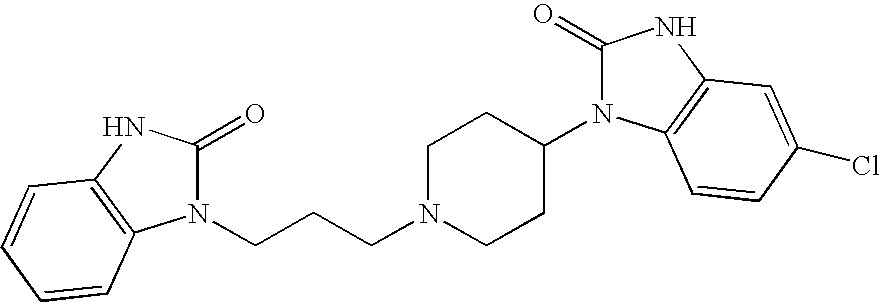Methods of using domperidone to terminate acute episodes of cardiac arrhythmia, to restore normal sinus rhythm or heart rate, to prevent recurrence of cardiac arrhythmia and to maintain normal sinus rhythm or heart rate in mammals
a technology of acute episodes and domperidone, which is applied in the direction of cardiovascular disorders, biocide, drug compositions, etc., can solve the problems of af, reduced use, and inability to prevent af recurrence, so as to prevent a recurrence of cardiac arrhythmia, and maintain normal sinus rhythm or heart ra
- Summary
- Abstract
- Description
- Claims
- Application Information
AI Technical Summary
Benefits of technology
Problems solved by technology
Method used
Image
Examples
example
[0054]In a study conducted to measure the in vitro effect of domperidone, currents in mammalian cells stable transfected with cloned ion channel cDNAs were observed.
[0055]Voltage clamp currents from each cell were recorded continuously before and after equilibration with domperidone. Each cell acted as its own control and the effect of domperidone was quantified as the ratio, in each cell, of current magnitude after equilibration with domperidone to current magnitude in control. Nonlinear least squares fits of the current ratio data yielded the best fit value for the IC50 concentration. A positive control was included for each channel tested in the study. The results are shown in the following table.
TABLE 1EstimatedEstimated% Block atIC50 at 0.1 Hz% Block atIC50 at 3 HzChannel10 μM / 0.1 Hz(μm)1 μM / 3 Hz(μM)hERG95.50.4798.00.4hNav1.537.341.823.73.2hCav3.249.410.2451.22hCav1.29101.149.61.01hKv4.30.51990hHCN420.330.3hNav1.34.6207.4hKv1.11.9516.3hKv1.317.646.8
PUM
| Property | Measurement | Unit |
|---|---|---|
| Fraction | aaaaa | aaaaa |
| Fraction | aaaaa | aaaaa |
| Fraction | aaaaa | aaaaa |
Abstract
Description
Claims
Application Information
 Login to View More
Login to View More - R&D
- Intellectual Property
- Life Sciences
- Materials
- Tech Scout
- Unparalleled Data Quality
- Higher Quality Content
- 60% Fewer Hallucinations
Browse by: Latest US Patents, China's latest patents, Technical Efficacy Thesaurus, Application Domain, Technology Topic, Popular Technical Reports.
© 2025 PatSnap. All rights reserved.Legal|Privacy policy|Modern Slavery Act Transparency Statement|Sitemap|About US| Contact US: help@patsnap.com

